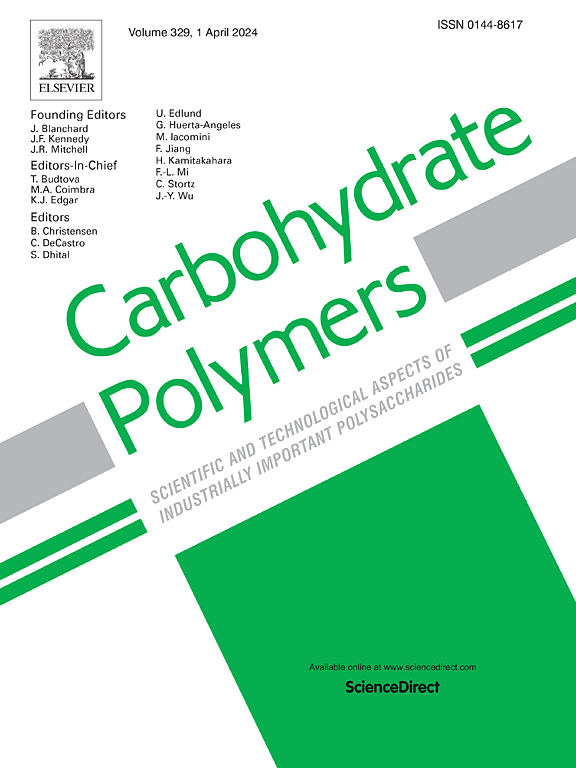生物炭注入纤维素泡沫与聚乙二醇基相变材料增强热能储存和光热性能
IF 12.5
1区 化学
Q1 CHEMISTRY, APPLIED
引用次数: 0
摘要
本研究提出了用生物炭增强纤维素基泡沫,并与聚乙二醇基相变材料(PCMs)相结合,以增强热能储存和光热性能。泡沫材料采用节能、非冷冻干燥的方法制造,利用纤维素固有的孔隙度和结构完整性来创建可持续和可扩展的材料平台。优化后的纤维素泡沫具有高孔隙率(85%)、低密度(66 kg·m−3)和最小收缩率(5%)的良好平衡组合,确保了多种应用的稳定性。纤维素、聚乙二醇和生物炭之间的亲疏水相互作用在实现PCM均匀分散、实现有效的热能储存(130 J·g−1)和温度调节方面发挥了关键作用。耐久性测试证实了相变性能在100次热循环中的稳定性,证明了材料的长期弹性。生物炭的掺入通过增强光吸收和导热性显著提高光热效率(85%),同时也增强了纤维素基质。生命周期评估(LCA)强调了环境权衡,其中生物炭有助于碳固存,而PEG带来了更高的碳足迹,但抵消了其他环境负担。这项工作强调了纤维素在开发可持续的生物基热管理材料中的多功能作用,为传统的绝缘和储能系统提供了一种环保的替代品。本文章由计算机程序翻译,如有差异,请以英文原文为准。

Biochar-infused cellulose foams with PEG-based phase change materials for enhanced thermal energy storage and photothermal performance
This study presents cellulose-based foams reinforced with biochar and integrated with polyethylene glycol (PEG)-based phase change materials (PCMs) to enhance thermal energy storage and photothermal performance. The foams were fabricated using an energy-efficient, non-freeze-drying method, leveraging cellulose's inherent porosity and structural integrity to create a sustainable and scalable material platform. The optimized cellulose foams exhibited a well-balanced combination of high porosity (85 %), low density (66 kg·m−3), and minimal shrinkage (5 %), ensuring stability across multiple applications. The hydrophilic–hydrophobic interactions between cellulose, PEG, and biochar played a crucial role in achieving uniform PCM dispersion, enabling effective thermal energy storage (130 J·g−1) and temperature regulation. Durability tests confirmed the stability of phase-change properties over 100 thermal cycles, demonstrating long-term material resilience. The incorporation of biochar significantly improved photothermal efficiency (85 %) by enhancing light absorption and thermal conductivity while also reinforcing the cellulose matrix. A life cycle assessment (LCA) highlighted the environmental trade-offs, where biochar contributed to carbon sequestration, while PEG introduced a higher carbon footprint but offset other environmental burdens. This work underscores the multifunctional role of cellulose in developing sustainable, bio-based thermal management materials, providing an eco-friendly alternative to conventional insulation and energy storage systems.
求助全文
通过发布文献求助,成功后即可免费获取论文全文。
去求助
来源期刊

Carbohydrate Polymers
化学-高分子科学
CiteScore
22.40
自引率
8.00%
发文量
1286
审稿时长
47 days
期刊介绍:
Carbohydrate Polymers stands as a prominent journal in the glycoscience field, dedicated to exploring and harnessing the potential of polysaccharides with applications spanning bioenergy, bioplastics, biomaterials, biorefining, chemistry, drug delivery, food, health, nanotechnology, packaging, paper, pharmaceuticals, medicine, oil recovery, textiles, tissue engineering, wood, and various aspects of glycoscience.
The journal emphasizes the central role of well-characterized carbohydrate polymers, highlighting their significance as the primary focus rather than a peripheral topic. Each paper must prominently feature at least one named carbohydrate polymer, evident in both citation and title, with a commitment to innovative research that advances scientific knowledge.
 求助内容:
求助内容: 应助结果提醒方式:
应助结果提醒方式:


